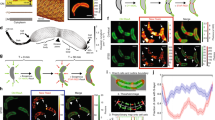Abstract:
The template-directed formation of regular nanoparticle arrays on two-dimensional crystalline protein layers after their treatment with metal salt complexes was studied by transmission electron microscopy. For these investigations, bacterial surface layers (S layers), recrystallized in vitro into sheets and tube-shaped protein crystals with typical dimensions in the micrometer range, were used as the template. As identified by electron holography and scanning force microscopy, the S-layer tubes form alternating double layers when deposited onto a solid substrate surface. Two distinct pathways for the metal particle formation at the templates have been found: the site-specific growth of metal clusters by chemical reduction of the metal salt complexes, and the electron-beam induced growth of nanoparticles in the transmission electron microscope. Both mechanisms lead to regular arrays with particle densities > 6×1011 cm -2. Nanoparticle formation by electron exposure takes exclusively place in the flat-lying double-layered protein tubes, where a sufficient amount of metal complexes can be accumulated during sample preparation.
Similar content being viewed by others
Author information
Authors and Affiliations
Additional information
Received 6 December 2000
Rights and permissions
About this article
Cite this article
Mertig, M., Wahl, R., Lehmann, M. et al. Formation and manipulation of regular metallic nanoparticle arrays on bacterial surface layers: an advanced TEM study. Eur. Phys. J. D 16, 317–320 (2001). https://doi.org/10.1007/s100530170119
Issue Date:
DOI: https://doi.org/10.1007/s100530170119




